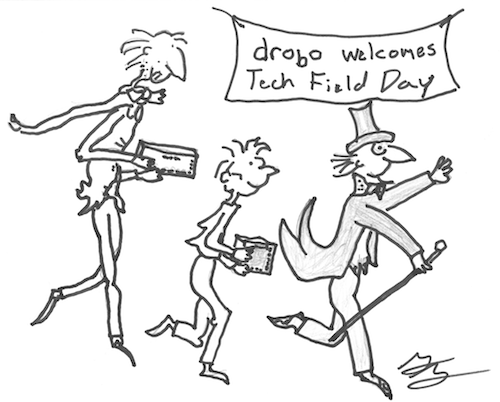
Data Robotics spent the last year transforming itself from a maker of expensive consumer storage devices to a player in the nascent small enterprise storage array market. That process took another step this week, as Data Robotics officially renamed itself Drobo. It is ironic that the company would shed a longer, corporate sounding name for the familiar consumer product designation, but there is no denying the power of the Drobo brand.
Drobo’s Transformation
Data Robotics was founded by storage industry pioneer Geoff Barrall, who wanted to transform the storage industry with flexibility and ease-of-use as central components. The Data Robotics team developed a simple four bay home storage device and gave it the name, Drobo. This was a basic and low performance device but found many takers in the prosumer market thanks to its innovative “BeyondRAID” technology.
BeyondRAID gave the little Drobo amazing powers: Thin provisioning meant that the device would flexibly accommodate nearly any combination of hard disk drives without requiring the user to delete and migrate data, and the unit could be expanded simply by swapping out smaller drives for larger ones. But the four slot unit was slow and expensive compared to feature packed but less friendly alternatives. By 2008, it seems that Data Robotics had expended all it could.
This changed in April of 2009 with the introduction of the eight bay DroboPro. Although still fairly limited, the DroboPro indicated that data robotics was serious about expanding into new markets, especially small business datacenters. The real innovation appeared later that year with the introduction of the high-performance Drobo S and iSCSI DroboElite, a sneak preview of which was a highlight of the Tech Field Day event I put together that November.
Big Changes
Unbeknownst to me, bigger things were afoot behind the scenes at Data Robotics in 2009. Entrepreneurial founder Barrall, whom I remain close to, was replaced as CEO less than a month later by storage industry veteran, Tom Buiocchi. The board decided to accelerate the development of business focused storage devices like the DroboElite, and development was underway on an entire new product line.
DroboFS, introduced in April at the second Tech Field Day event, brought an integrated file system interface to the same five-day form factor of the Drobo S. This was a much better solution than the existing DroboShare add-on device, though I was less enthusiastic about the prospect of running third-party software on the device.
Drobo continued moving in the direction of small business datacenters needs, and their introduction in early 2011 of a business focused line of storage devices came as no surprise to industry insiders. The new family of products, once again previewed at Tech Field Day, included eight bay and 12 bay devices with iSCSI or NAS capability, automated tiered storage, and VMware and Microsoft certification.
Although the B1200i, B800i, and B800fs still lack many of the enterprise features found in higher-end storage devices, they have proved themselves in the market. I have found these devices in many small business datacenters, all of whom praised them for their simplicity and flexibility.
Drobo. Just Drobo.
The Drobo marketing team hinted to me earlier this year that the Data Robotics name was on the way out. They felt that the positive connotations of “Drobo” outweighed its familiar association with consumer products, and I must agree. I know very few people, other than industry insiders, who ever even heard of the Data Robotics brand, yet many photographers, IT geeks, and consumer electronics enthusiasts have brought up Drobo in conversation.
Going with the Drobo name seems logical for the company, though they will have to overcome the stigma of starting out as a consumer electronics company. Small businesses seem to have no trouble at all having a Drobo in their data center, but what about larger organizations? Will an enterprise be willing to accept a Drobo branded product even for small office or remote office use? Or will they rejected out of hand, assuming it is the same old consumer electronics device they may have heard of?
I remain impressed by the Drobo technology, and the evolution of BeyondRAID is heading in the right direction. Drobo remains the only device that really nails thin provisioning on the storage array, and this gives it a real leg up when developing advanced features. Although Drobo storage devices are expensive, they are worth it if you value the kind of ease-of-use and flexibility they offer. I personally bought a four bay Drobo unit for my day-to-day storage needs, and am in the process of upgrading to a second-generation Drobo S. I look forward to seeing more progress from the company now known as Drobo in the days ahead.
Disclaimer: I was a Drobo buyer before I got anything from the company, but have developed close relationships since then. They have sponsored three of the Tech Field Day events I organize, have provided me and my friends with review units, and are always available to take my calls. That being said, Drobo did not encourage or sponsor this or any other article I have written about the company, and did not alert me to this name change announcement ahead of time.
Simplicity and specificity has a power all to itself. There are so many customers that appreciate having a device that just does what it says, and especially when we’re talking about a home or smb nas: most of the time they get loaded up with a bunch of data, and they’re the only device that has that much storage on premise, so it’s not really helpful if you want to increase storage because you end up losing all of your data.